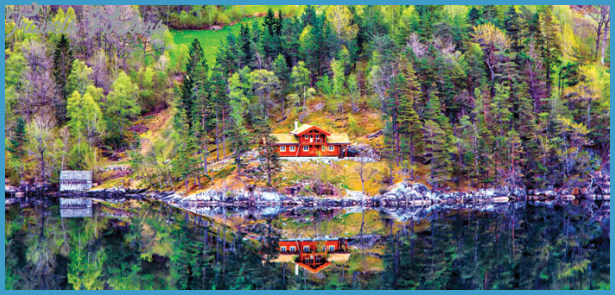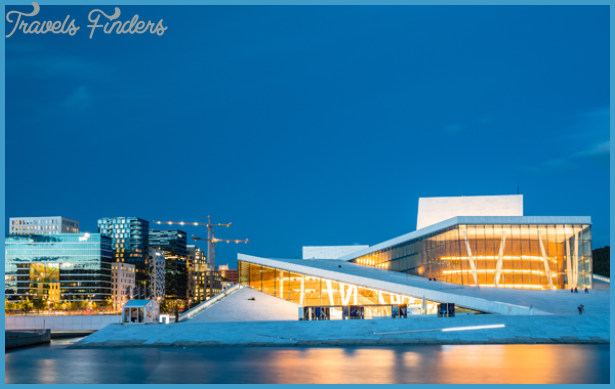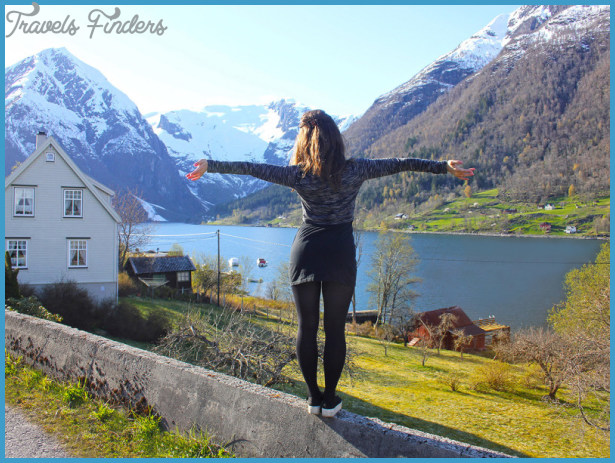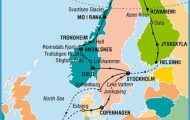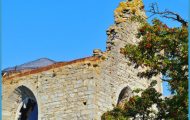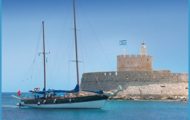Lidkoping (pop. 25,000; Stadshotellet, 89 Gyllene Ornen, 35 Skoldmon, 1 0 Park, 10 b.), located on the Kinnevik, at the mouth of the LidaS, is a port and industrial town with a number of modest industrial establishments, the most famous of which is the Rorstrand porcelain manufactory, established here in 1935. Lidkoping received its municipal charter in 1446, when the town lay on the E bank of the Lidaci. When Magnus Gabriel de la Gardie was granted the right to build a town in the county of Lacko in 1670, he laid it out on the W bank, reaching straight down to the river, and the street pattern survives to a large extent in present-day Lidkoping. In the Stora Torg Count de la Gardie built a hunting lodge; it later became the Town Hall but burned down in 1960. The new Town Hall was rebuilt on the basis of
the original plans. In the square is a statue of de la Gardie. Gamla Staden, the Old Town around the Limtorg, has preserved its original buildings ancj old-world character.
To the N of Lidkoping, the peninsula of Kallandshalvd reaches out into the lake. Off its northern tip is the rocky island of Kallandso, on the shores of which stands Lacko Castle, originally built by Bishop Brynolt Algotsson (1298). Investigation has shown that this medieval stronghold, which was much altered in later centuries, had roughly the same ground plan as the present castle. In 1557, after the Reformation, the property passed to the Crown; soon afterward it came into the hands of Svante Sture, and in 1571 was acquired by the Hogenskild Bielke family, who undertook a thorough restoration. In 1615, General Jacob de la Gardie, husband of Ebba Brahe, was granted possession of Lacko Castle along with the title of count. His son, Magnus, did large-scale work on the castle, bringing in two German architects, Elias Holl and Frans Stiemer; they added a fourth floor, new kitchens and an outer work. In 1746, Frederik I had the portrait of Jacob de la Gardie which hung in the Knights’ Hall (richly decorated with scenes from the Thirty Years War) removed to Stockholm; it now hangs in the Military Academy on the Karlsberg. In 1810, Lacko Castle was granted to General Carl Johan Adlercreutz, victor in the battle of Siikajoki, and was renamed Siikajoki in his honour. In 1920, the castle was again thoroughly restored. Since 1965, it has belonged to the Vastergotland Tourist Association, which holds exhibitions in the castle during the summer.
SE of Lidkoping, away from the lake, lies Skara (alt. 113m (370 ft); pop. 11,000; Tre Hastar Motell, 85 Angle, 72 Stadshotell, 60 youth hostel; camp site), which developed around an ancient place of assembly [thing) and cult site. In the Middle Ages, it became the home of Christian missionaries and the see of a bishop; the seminary for priests established here in the 13th c. was the forerunner of the grammar school founded in 1641. Skara can also claim the first veterinary school in Sweden (1775, now a museum). The Cathedral, originally Gothic (1312-50), was extensively altered in later centuries. The major part of the church (the early 13th c. choir, the early 14th c. nave) is in High Gothic style; the towers date from an early 19th c. rebuilding. The rather unsatisfactory restoration work carried out at the end of the 19th c. was largely corrected after a fire in 1947. In the aisle is the marble sarcophagus of Erik Soop, a cavalry colonel who saved Gustavus Adolphus’s life during the Thirty Years War in 1629. In the Romanesque crypt, below the choir, can be seen the tomb of one of the first bishops, Adalvard. Opposite the Cathedral is the Diocesan Library. Farther N lies the Municipal Park, with the Vastergotland Museum (Fornminnes-museum) and an open-air museum; together they give a varied and comprehensive picture of life in this region in earlier times. The open-air museum contains a church, as well as old peasants’ houses. In the Stora Torg stands a fine bronze fountain by N. Sjogren (1894).
Varnhem 14 km (9 miles) E of Skara, has a 13th c. church which originally belonged to a Cistercian abbey. It was the burial-place of the kings of Erik’s dynasty, and also contains the tomb of Birger Jarl, who died in Vastergotland in 1266. After the








